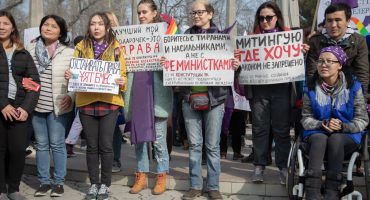Not so long ago, most countries considered the Taliban as terrorists. However, recent events in Afghanistan made the group the primary newsmaker for many global and local media. The representatives of the Taliban (banned in Central Asian countries and recognised as a terrorist organisation) are interviewed and hold press conferences; the photos and videos of them are on every news website.
Amid these events, the journalists should remember what terrorism is and how to cover this topic correctly.
This term has always been the subject of controversy.
“One person’s terrorist is another person’s freedom fighter”, “Today’s terrorist is tomorrow’s statesperson” – these recurring phrases have become clichés in journalistic and political commentaries. Thus, using the terms ‘terrorism’, as well as ‘terrorist’ is never neutral.
Terrorism is a catchall term that can refer to a tactic or an ideology, as well as a crime or an act of war.
There are dozens of definitions of ‘terrorism’, which often emphasise specific points, reflecting a political or moral approach.
“A major hindrance in the way of achieving a widely accepted definition of political terrorism is the negative emotional connotation of the term. Terrorism has become merely another derogatory word, rather than a descriptor of a specific type of activity. Usually, people use the term as a disapproving label for a whole variety of phenomena which they do not like, without bothering to define precisely what constitutes terroristic behaviour,” wrote Ariel Merari, professor at the International Institute for Counter-Terrorism, Tel Aviv University.
Although the term comes up in many texts and conventions, there is currently no agreed-upon definition within the United Nations (UN).
You can, but do it very accurately. There are specific terms describing the actions of certain terrorist organisations. For example, you can use words ‘bombers’ or ‘attackers’. If you report on a convicted criminal, it would be more ethical to call him/her ‘a person convicted of terrorism’ rather than just a ‘terrorist’.
In any case, a great restraint is required in the news, and the priority must be placed on describing an act of violence rather than qualifying it.
There is an important rule for the use of the terms ‘terrorist’ and ‘terrorism’: these terms must be used relevantly, not to exaggerate the status or the consequences of radical protests.
A journalist has to pursue the truth. This means that the facts must be scrupulously established and verified.
The pursuit of truth also implies the duty to explain, even though this is sometimes perceived as justifying terrorist acts. Decoding the origins of terrorist acts and terrorist demands is, however, essential.
The brutality of a violent act cannot serve as a pretext to refuse to analyse it.
The media should remember about responsibility to others. The media’s reports inevitably have an impact on people, institutions, companies, etc. Therefore, it is the media’s duty to minimise the negative impact of the dissemination of information. It is necessary to remember about the protection of the possible hostages, the dignity of the victims, the safety of security-force operations. The media should find the balance between comprehensive information, self-censorship, intimidation, and state propaganda.
Number of attacks per year, typology of the victims, assessment of counter-terrorist actions, percentage of terrorists in the population, proportion of acts according to the ideology or the religion of the perpetrators, etc. The topic of terrorism abounds with figures.
However, when using such figures, caution is required, since there will always be those interpreting the statistics for their purposes: the supporters of radical methods of fighting terrorism, or those who justify the criminals’ actions.
In addition, all numerical data must imperatively be checked, along with the methodology used to compile it. Its purpose and the source of dissemination must also be underlined.
Several questions should be posed when working with conflict-related statistics: Who came up with them? Why? How? For whom?
In addition, figures do not show everything. Statistically smaller or less numerous attacks can have a far greater political and societal impact.
Today, when terrorist groups have their own technical teams to disseminate the messages about their violent actions, and social media become a source of such information, this question becomes critical.
The media wants to publish the images to fulfil their duty to inform the public. At the same time, they must concern for the dignity of victims and avoid becoming a platform for the propaganda of hatred or terrorist ideology.
Some popular media choose not to publish photos or videos related to terrorism to avoid the glorification of the terrorists – during their lives or posthumous.
If the photos or videos are necessary for your material, avoid excessive glamorisation of criminals – do not use colourful, bright, compositional photos showing the terrorists, for example, posing with hostages or with weapons.
Potentially shocking videos and photos should be published with a warning. It is necessary to give a choice to your audience: to continue to watch such content or not.
Publishing images of children is generally subject to strict legal and ethical standards in all countries, especially when the images feature injured, traumatised, or deceased children. However, the media regularly publish photos of child victims, believing that they reflect a reality from which we should not turn away.
Nevertheless, there is an alternative. Instead of using a photo of a dead or injured child, the picture of a child’s clothes covered with blood can be used. Both these images convey the same message but the second one is less shocking for the audience.
Terrorist attacks often reveal the prejudices that reign among the media and society in general. These prejudices lie behind the temptation to disseminate rumours incriminating members of specific communities. Such news shortcuts create risks of stigmatising or even criminalising the entire religious, ethnic, national, or political groups.
One of such common generalisations is the phrase ‘Islamist terrorism’.
Unfortunately, a significant part of the public and the media are inclined to accuse the entire Muslim population of terrorism. However, the actions of the Norwegian terrorist Andres Breivik do not make anyone accuse the “Western civilisation”.
Monitor and check them. The media cannot disseminate prejudices and stereotypes. The media should not fuel fear and panic, or stigmatise communities.
This material was created based on the UNESCO Handbook for Journalists related to the coverage of terrorism.
Title photo: freepik.com
This publication was produced as part of the mentorship programme under the Development of New Media and Digital Journalism in Central Asia project delivered by the Institute for War and Peace Reporting (IWPR) with support from the UK Government. It does not necessarily reflect the official views of IWPR or the UK Government
If you have found a spelling error, please, notify us by selecting that text and pressing Ctrl+Enter.





